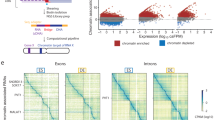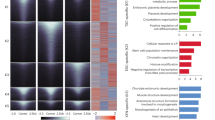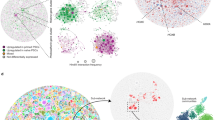Abstract
In multicellular organisms, transcription regulation is one of the central mechanisms modelling lineage differentiation and cell-fate determination1. Transcription requires dynamic chromatin configurations between promoters and their corresponding distal regulatory elements2. It is believed that their communication occurs within large discrete foci of aggregated RNA polymerases termed transcription factories in three-dimensional nuclear space3. However, the dynamic nature of chromatin connectivity has not been characterized at the genome-wide level. Here, through a chromatin interaction analysis with paired-end tagging approach3,4,5 using an antibody that primarily recognizes the pre-initiation complexes of RNA polymerase II6, we explore the transcriptional interactomes of three mouse cells of progressive lineage commitment, including pluripotent embryonic stem cells7, neural stem cells8 and neurosphere stem/progenitor cells9. Our global chromatin connectivity maps reveal approximately 40,000 long-range interactions, suggest precise enhancer–promoter associations and delineate cell-type-specific chromatin structures. Analysis of the complex regulatory repertoire shows that there are extensive colocalizations among promoters and distal-acting enhancers. Most of the enhancers associate with promoters located beyond their nearest active genes, indicating that the linear juxtaposition is not the only guiding principle driving enhancer target selection. Although promoter–enhancer interactions exhibit high cell-type specificity, promoters involved in interactions are found to be generally common and mostly active among different cells. Chromatin connectivity networks reveal that the pivotal genes of reprogramming functions are transcribed within physical proximity to each other in embryonic stem cells, linking chromatin architecture to coordinated gene expression. Our study sets the stage for the full-scale dissection of spatial and temporal genome structures and their roles in orchestrating development.
This is a preview of subscription content, access via your institution
Access options
Subscribe to this journal
Receive 51 print issues and online access
$199.00 per year
only $3.90 per issue
Buy this article
- Purchase on Springer Link
- Instant access to full article PDF
Prices may be subject to local taxes which are calculated during checkout




Similar content being viewed by others
References
Neph, S. et al. Circuitry and dynamics of human transcription factor regulatory networks. Cell 150, 1274–1286 (2012)
Visel, A. et al. ChIP-seq accurately predicts tissue-specific activity of enhancers. Nature 457, 854–858 (2009)
Li, G. et al. Extensive promoter-centered chromatin interactions provide a topological basis for transcription regulation. Cell 148, 84–98 (2012)
Handoko, L. et al. CTCF-mediated functional chromatin interactome in pluripotent cells. Nature Genet. 43, 630–638 (2011)
Fullwood, M. J. et al. An oestrogen-receptor-α-bound human chromatin interactome. Nature 462, 58–64 (2009)
Phatnani, H. P. & Greenleaf, A. L. Phosphorylation and functions of the RNA polymerase II CTD. Genes Dev. 20, 2922–2936 (2006)
Evans, M. J. & Kaufman, M. H. Establishment in culture of pluripotential cells from mouse embryos. Nature 292, 154–156 (1981)
Conti, L. et al. Niche-independent symmetrical self-renewal of a mammalian tissue stem cell. PLoS Biol. 3, e283 (2005)
Zappone, M. V. et al. Sox2 regulatory sequences direct expression of a β-geo transgene to telencephalic neural stem cells and precursors of the mouse embryo, revealing regionalization of gene expression in CNS stem cells. Development 127, 2367–2382 (2000)
Spilianakis, C. G., Lalioti, M. D., Town, T., Lee, G. R. & Flavell, R. A. Interchromosomal associations between alternatively expressed loci. Nature 435, 637–645 (2005)
Shen, Y. et al. A map of the cis-regulatory sequences in the mouse genome. Nature 488, 116–120 (2012)
Chen, X. et al. Integration of external signaling pathways with the core transcriptional network in embryonic stem cells. Cell 133, 1106–1117 (2008)
Kagey, M. H. et al. Mediator and cohesin connect gene expression and chromatin architecture. Nature 467, 430–435 (2010)
Hardison, R. C. & Taylor, J. Genomic approaches towards finding cis-regulatory modules in animals. Nature Rev. Genet. 13, 469–483 (2012)
Bernstein, B. E. et al. A bivalent chromatin structure marks key developmental genes in embryonic stem cells. Cell 125, 315–326 (2006)
Rada-Iglesias, A. et al. A unique chromatin signature uncovers early developmental enhancers in humans. Nature 470, 279–283 (2011)
Li, Q. et al. A systematic approach to identify functional motifs within vertebrate developmental enhancers. Dev. Biol. 337, 484–495 (2010)
Nolis, I. K. et al. Transcription factors mediate long-range enhancer–promoter interactions. Proc. Natl Acad. Sci. USA 106, 20222–20227 (2009)
Yu, J. et al. Induced pluripotent stem cell lines derived from human somatic cells. Science 318, 1917–1920 (2007)
Jaenisch, R. & Young, R. Stem cells, the molecular circuitry of pluripotency and nuclear reprogramming. Cell 132, 567–582 (2008)
Ring, K. L. et al. Direct reprogramming of mouse and human fibroblasts into multipotent neural stem cells with a single factor. Cell Stem Cell 11, 100–109 (2012)
Pollard, S. M., Wallbank, R., Tomlinson, S., Grotewold, L. & Smith, A. Fibroblast growth factor induces a neural stem cell phenotype in foetal forebrain progenitors and during embryonic stem cell differentiation. Mol. Cell. Neurosci. 38, 393–403 (2008)
Ligon, K. L. et al. Olig2-regulated lineage-restricted pathway controls replication competence in neural stem cells and malignant glioma. Neuron 53, 503–517 (2007)
Levine, M. Paused RNA polymerase II as a developmental checkpoint. Cell 145, 502–511 (2011)
Jinek, M. et al. A programmable dual-RNA-guided DNA endonuclease in adaptive bacterial immunity. Science 337, 816–821 (2012)
Li, G. et al. ChIA-PET tool for comprehensive chromatin interaction analysis with paired-end tag sequencing. Genome Biol. 11, R22 (2010)
Bastian, M., Heymann, S. & Jacomy, M. Gephi: an open source software for exploring and manipulating networks http://www.aaai.org/ocs/index.php/ICWSM/09/paper/view/154 and https://gephi.org/users/publications/ (International AAAI Conference on Weblogs and Social Media, 2009)
Meissner, A. et al. Genome-scale DNA methylation maps of pluripotent and differentiated cells. Nature 454, 766–770 (2008)
Bolli, N. et al. Expression of the cytoplasmic NPM1 mutant (NPMc+) causes the expansion of hematopoietic cells in zebrafish. Blood 115, 3329–3340 (2010)
Siepel, A. et al. Evolutionarily conserved elements in vertebrate, insect, worm, and yeast genomes. Genome Res. 15, 1034–1050 (2005)
Acknowledgements
The authors thank J. Mariani for the preparation of RNA from NPC; K. Murphy and A. Ku for their assistance with zebrafish enhancer assays; and A. Visel and A. Nord for discussion and their comments on the manuscript. S.N. and R.F. were supported by grants from ASTIL Regione Lombardia (SAL-19 ref. no. 16874), Telethon (GGP12152), Cariplo (Rif. 2010-0673) and AIRC (IG-5801). N.A. is supported by NINDS grant number R01NS079231, NICHD grant number R01HD059862, NHGRI grant numbers R01HG005058 and R01HG006768, NIDDK award number R01DK090382, NIGMS award number GM61390 and Simons Foundation SFARI no. 256769. R.Y.B. is supported by NINDS grant number R01NS079231 and the UCSF Program for Biomedical Breakthrough Research (PBBR). This work was supported by Agency for Science, Technology and Research (A*STAR), Singapore, the Office of Science of the U.S. Department of Energy under contract no. DE-AC02-05CH11231 and National Institutes of Health ENCODE grants (R01 HG004456-01, R01HG003521-01 and 1U54HG004557-01) to Y.R. and C.-L.W.
Author information
Authors and Affiliations
Contributions
Y.Z. constructed ChIA-PET experiments and data evaluation. R.Y.B. and N.A. designed and performed zebrafish enhancer assays. C.-H.W. carried out data analysis. C.-Y.N. and Y.Z. performed the RNA-seq experiments. J.L. performed DNA-FISH. H.M.P., E.T., R.F. and E.W. prepared the cells and ChIP material. G.L., F.H.M., W.-K.S. and Y.R. designed the data processing pipeline. C.-L.W. and S.N. designed the experiments. Y.Z. and C.-L.W. wrote the paper. All authors provided intellectual input and approved the final manuscript.
Corresponding author
Ethics declarations
Competing interests
The authors declare no competing financial interests.
Extended data figures and tables
Extended Data Figure 1 Enrichments of RNAPII ChIP by ChIP-qPCR in three cell lines.
a–c, Fold enrichments (y axes) of RNAPII ChIP in selected regions (x axes) from three different cell lines (mouse ESCs (a), NSCs (b) and NPCs (c)) are shown. Two replicates of ChIP were tested via ChIP-qPCR and are represented as different colours (red and blue).
Extended Data Figure 2 Schematic overview of ChIA-PET analysis.
RNAPII binding sites, intra- and interchromosomal interactions identified from each cell type are shown.
Extended Data Figure 3 Promoter-mediated interactions and associated gene expression levels in NSCs and NPCs.
a, Distribution of defined interaction between promoters, inter- and intragenic regions in NSCs (top) and NPCs (bottom). b, Boxplots of the expression level (RPKM, y axes) between genes tethered by RNAPII and genes without tethered interactions (x axes) in NSCs (top) and NPCs (bottom).
Extended Data Figure 4
Enhancers for Nanog (top left), Phc1 (top right), Lefty1 (bottom right) and Oct4 (bottom left) uncovered through 3C analysis in mESC V6.5 (middle black track) and ChIA-PET analysis in mESC E14 (bottom red track).
Extended Data Figure 5
Phylogenetic conservation represented by PhastCon scores30 of the putative enhancer regions in comparison with other types of genomic regions.
Extended Data Figure 6
NSC- and NPC-specific interactions detected from promoters of early developmental genes (left) Adam12 (top; chromosome 7:141165832—141495831), Vav3 (middle; chromosome 3:108932769—109282768) and Hoxa (bottom; chromosome 6:51730841—52230840) as well as key telencephalic homeobox transcription factors (right) Otx1 (top, chromosome 11:21878211—21998210) and Meis2 (bottom, chromosome 2:115603679—116003678). Dotted connecting lines depict the defined interactions with the distances labelled. The RNAPII binding peaks are shown in the middle track, followed by PET mapping in NSCs and NPCs, respectively.
Extended Data Figure 7 Examples for interacting promoter nodes with their cell specificity and enhancer connectivity found in all three cell types.
a, ESC-specific promoter nodes (Fzd7) with E:P (2:1). b, NSC- and NPC-specific promoter nodes (Fabp7) with E:P (1:1 and M:1 M: multiple, ≥2). c, Promoter nodes (Sox2) found in three different cell lines with dynamic E:P interactions.
Extended Data Figure 8 Connectivity constructed from the one-hop interactions mediated from reprogramming factor genes in ESCs.
Different colours represent different categories of cell specificity; the different sizes of the nodes represent non-promoter, promoter and iPS (induced pluripotent stem cell) factor nodes.
Extended Data Figure 9 Sox2-centric interaction map in NSCs.
All the interaction nodes directly connecting Sox2 are highlighted and gene names are labelled. The connectivities between Sox2, Myc and Pou3f2 are highlighted by thick grey lines.
Supplementary information
Supplementary Information
This file contains Supplementary Text and Data, Supplementary Figures and Supplementary References. (PDF 3869 kb)
Supplementary Data
This file contains Supplementary Table 1. (XLS 36 kb)
Supplementary Data
This file contains Supplementary Table 2. (XLS 5794 kb)
Supplementary Data
This file contains Supplementary Table 3. (XLS 47 kb)
Supplementary Data
This file contains Supplementary Table 4. (XLS 21 kb)
Supplementary Data
This file contains Supplementary Table 5. (XLS 1071 kb)
Supplementary Data
This file contains Supplementary Table 6. (XLS 1461 kb)
Supplementary Data
This file contains Supplementary Table 7. (XLSX 44 kb)
Supplementary Data
This file contains Supplementary Table 8. (XLSX 1874 kb)
Rights and permissions
About this article
Cite this article
Zhang, Y., Wong, CH., Birnbaum, R. et al. Chromatin connectivity maps reveal dynamic promoter–enhancer long-range associations. Nature 504, 306–310 (2013). https://doi.org/10.1038/nature12716
Received:
Accepted:
Published:
Issue Date:
DOI: https://doi.org/10.1038/nature12716
This article is cited by
-
Advances in the multimodal analysis of the 3D chromatin structure and gene regulation
Experimental & Molecular Medicine (2024)
-
3D genomics and its applications in precision medicine
Cellular & Molecular Biology Letters (2023)
-
3D organization of regulatory elements for transcriptional regulation in Arabidopsis
Genome Biology (2023)
-
A multi-omics integrative analysis based on CRISPR screens re-defines the pluripotency regulatory network in ESCs
Communications Biology (2023)
-
RNA-DNA interactomes of three prokaryotes uncovered by proximity ligation
Communications Biology (2023)
Comments
By submitting a comment you agree to abide by our Terms and Community Guidelines. If you find something abusive or that does not comply with our terms or guidelines please flag it as inappropriate.



